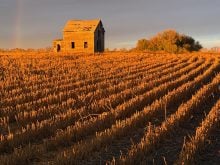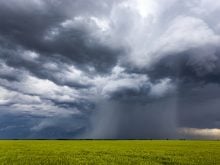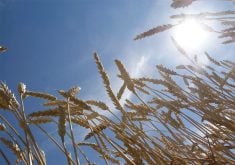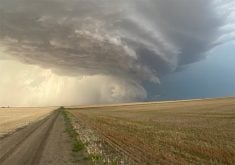We have all the weather data from the main reporting stations across the Prairies, so we can review August weather and then look at the latest three-month forecasts or predictions.
Instead of going province by province, I will rank the main reporting sites by mean temperature, how far above or below average it was, total precipitation, and how much above or below average the precipitation was.
Let’s start with the ranking of mean monthly temperatures across the Prairies.
Read Also

Farmers asked to keep an eye out for space junk
Farmers and landowners east of Saskatoon are asked to watch for possible debris in their fields after the re-entry of a satellite in late September.
Regina and Winnipeg were the two warmest locations, both around 19 C. They were followed by Dauphin, Saskatoon and Brandon, with readings of 18.3 C. Manitoba and Saskatchewan are basically tied as the warmest locations, and Alberta is the cold spot. It’s interesting to see the difference between this year’s mean average August temperature and the long-term average.
While Saskatchewan and Manitoba saw the warmest temperatures, with the exception of Regina, Alberta had the warmest temperatures compared to average and Manitoba was coolest.
Next is our look at precipitation, starting with total rainfall.
Compared to temperature data, precipitation data does not seem to follow the same trend. This is not unusual in summer, as much of our rainfall comes from convection or thunderstorms. These storms often travel in lines across parts of one province and into another province.
Two things stand out in this data. Calgary and Edmonton received significant rainfall in August. And, if you compare this with the weather map, it doesn’t seem to jive. I know the map does not perfectly cover August, because I didn’t grab the graphic on Sept. 1, but I found there were no missed or extra rainfall events during the first couple of days of August or September, so I’m not sure what is happening.
Not surprisingly, when comparing precipitation to the long-term average, Calgary and Edmonton come out on top with amounts 20 to 25 millimetres greater than average. On the opposite end, Winnipeg and Brandon were the dry spots at about 30 mm below average.
Overall, it was a slightly warmer than average August with western regions being the warmest compared to average and eastern regions right around average. Precipitation was a mixed bag thanks to the convective nature of summer rainfall. All three Prairie provinces had regions with below-average, near-average and above-average precipitation. This highlights the importance of having a good network of rainfall gauges.
NOAA’s latest three-month outlook, extrapolated northward, calls for slightly above-average temperatures and near-average precipitation. The best chance of above-average temperatures is over the eastern Prairies.
The CFS model forecasts well above-average temperatures in September across the Prairies with slightly above-average temperatures in October and below-average temperatures in November. Precipitation looks to be near- to slightly below-average, with only western Alberta expected to see above-average amounts.
The Canadian CanSIPS model is calling for above to well above-average temperature across the Prairies for all three months, along with near- to slightly below-average precipitation. Best chance of below-average precipitation is Manitoba.
The European model or ECMWF forecast calls for generally above-average temperatures with near-average precipitation.
My prediction: September looks likely to be an above-average temperature month with below-average precipitation. I think that warmer and drier conditions will continue in October, before slowly transitioning toward near- to below-average temperatures with near- to above-average precipitation in November.
Daniel Bezte is a teacher by profession with a BA in geography, specializing in climatology, from the University of Winnipeg. He operates a computerized weather station near Birds Hill Park, Man. Contact him at dmgbezte@gmail.com.


















